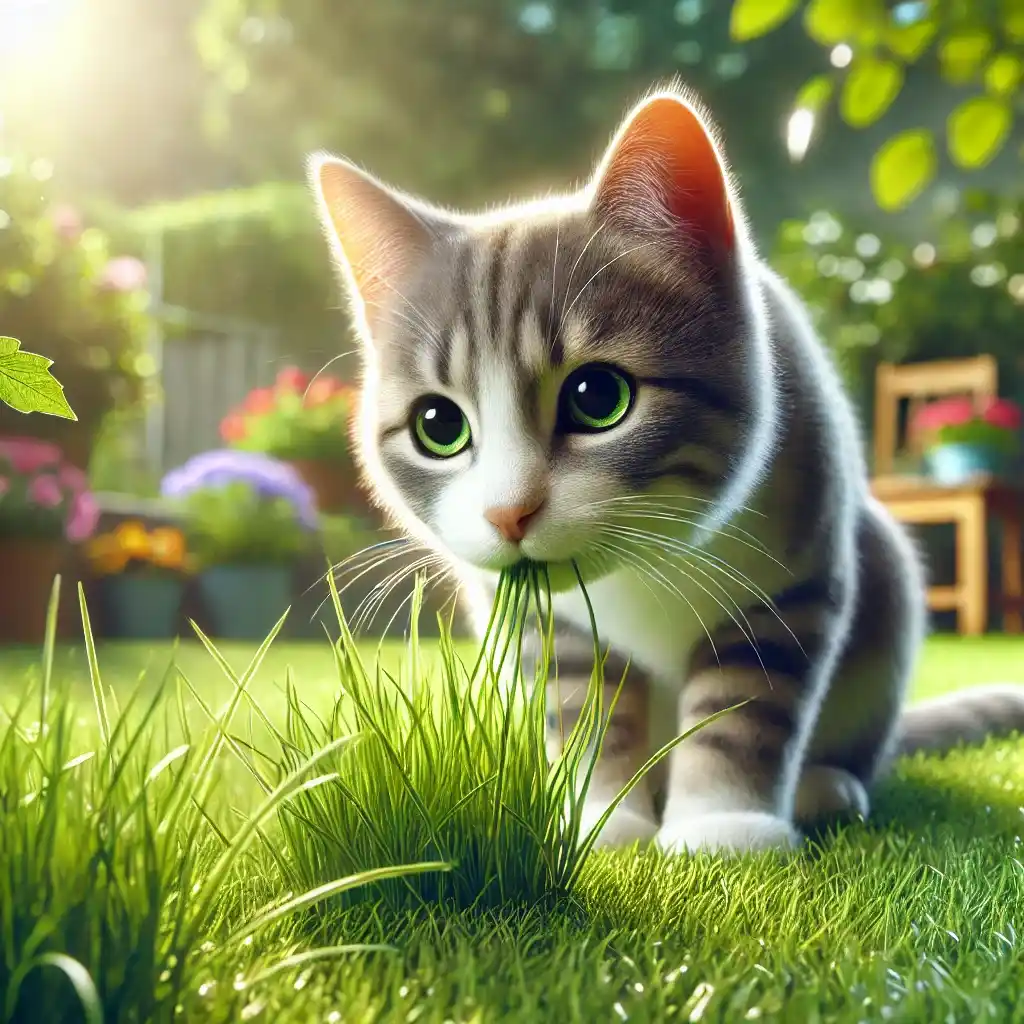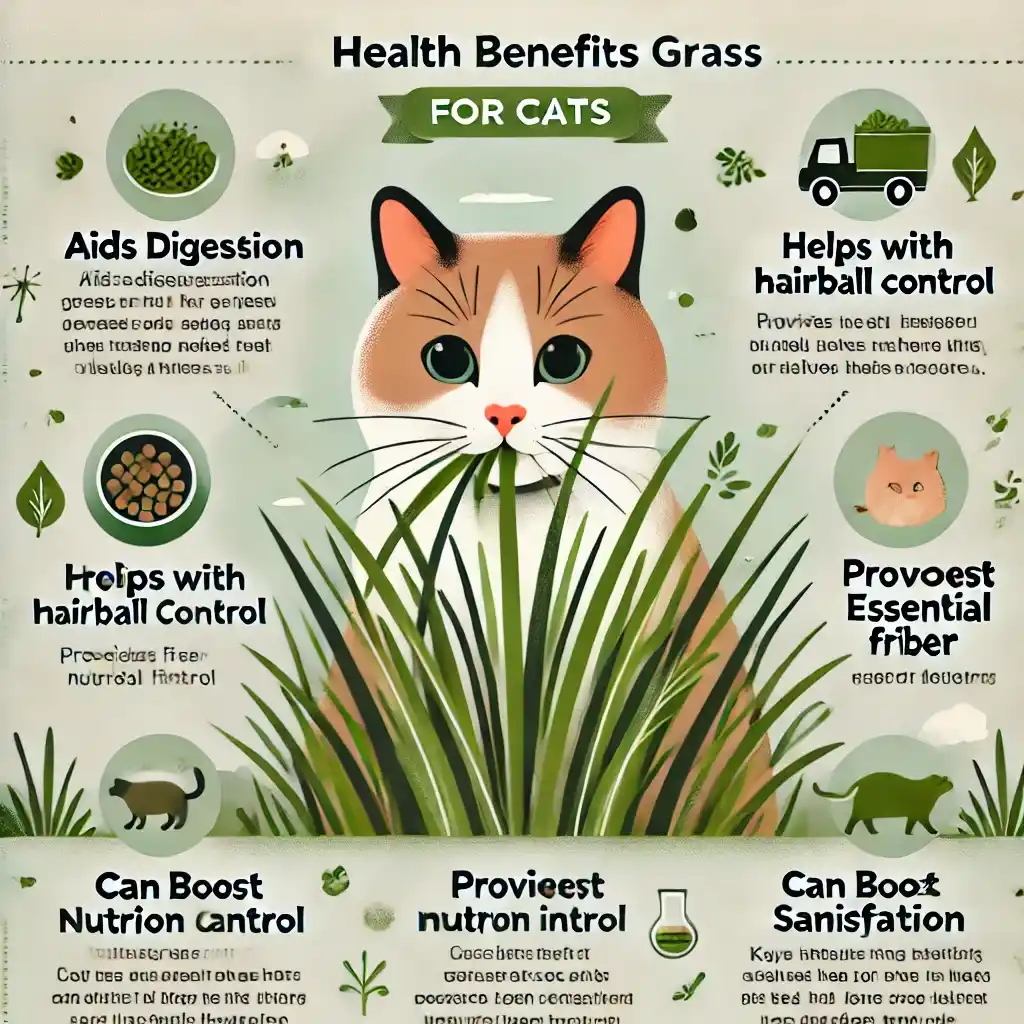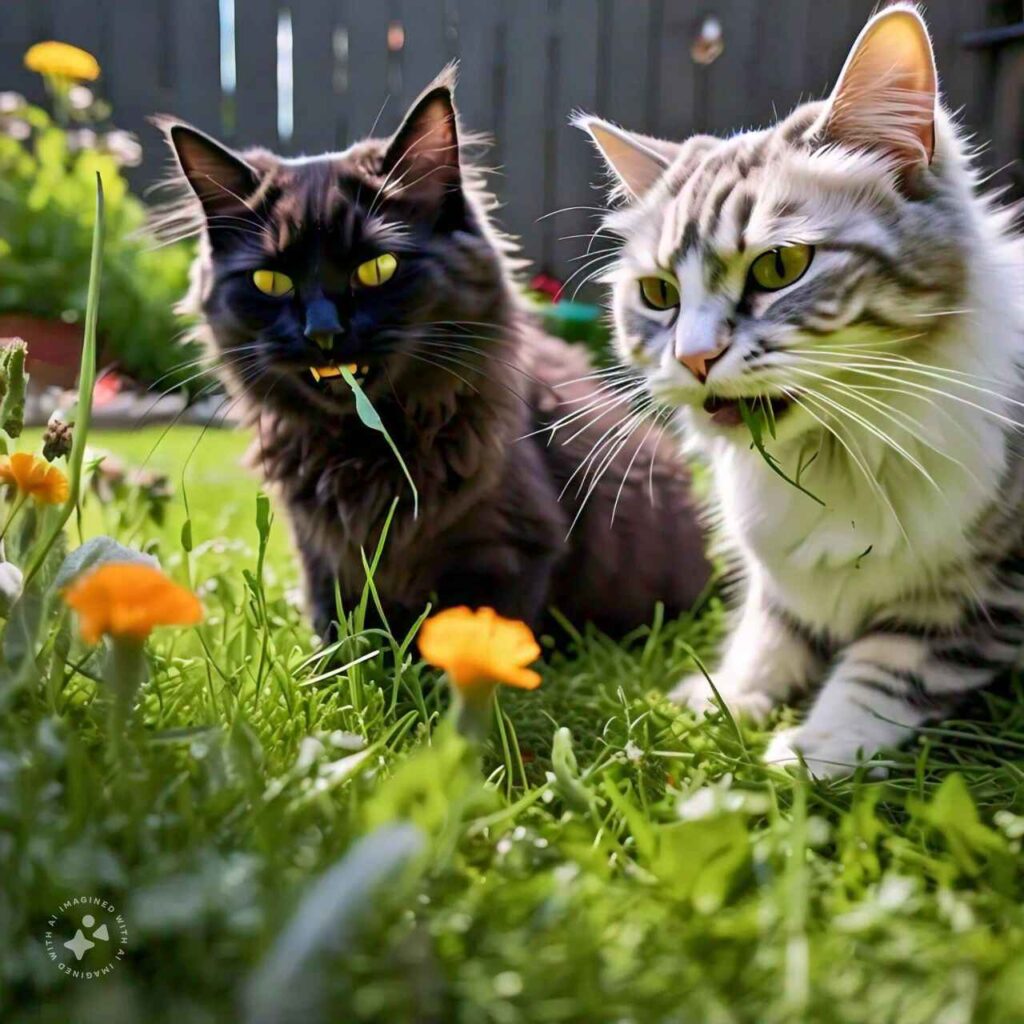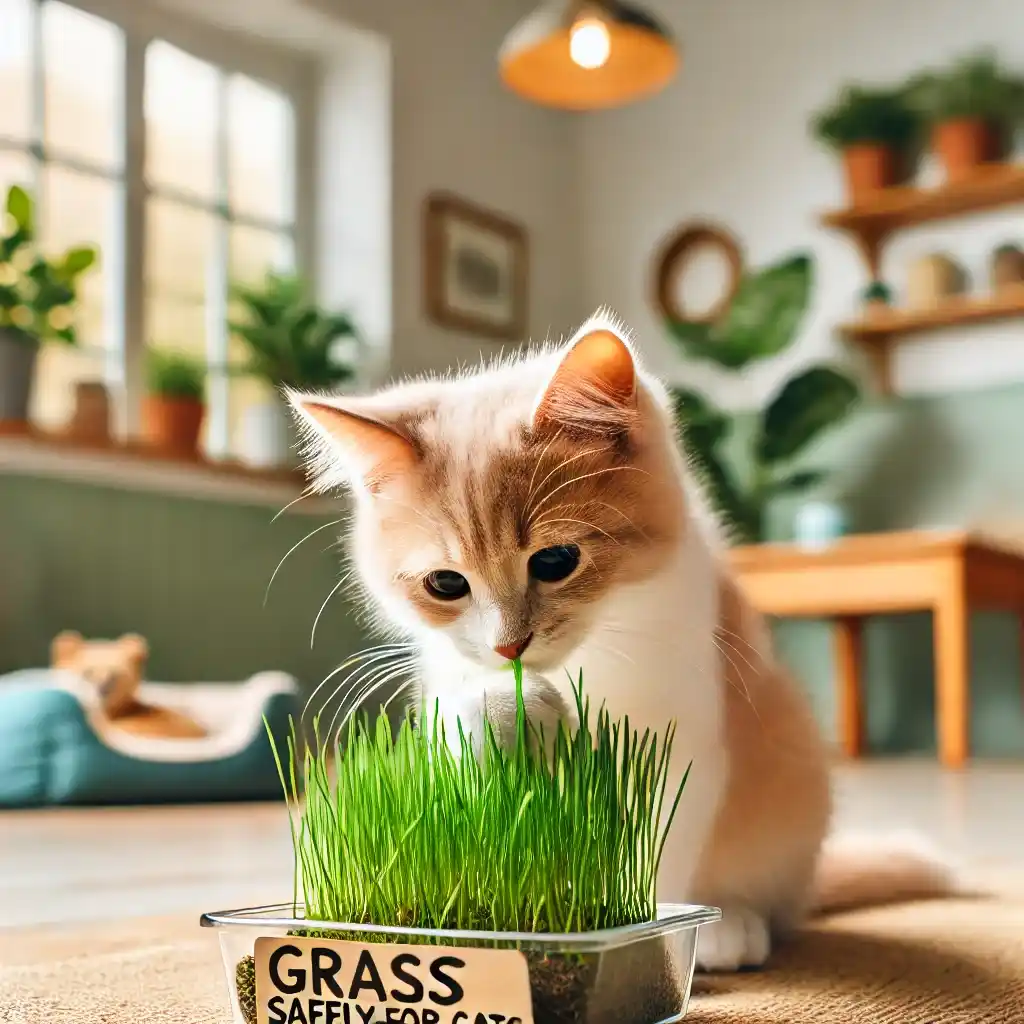1. Introduction
Why Cats Eat Grass
When it comes to the dietary habits of cats, many owners are intrigued to see their feline companions nibbling on grass. While cats are obligate carnivores, meaning they thrive on meat, they still may exhibit the curious behavior of eating plants, particularly grass. This behavior has ancient roots tied to the instincts and survival mechanisms of wild cats, which sometimes eat plants to aid in digestion or obtain certain vitamins. For instance, grass-eating can help promote intestinal motility, which could prevent blockages or discomfort from undigested materials in their gut.
Some researchers believe that cats might eat grass due to its high fiber content. Fiber aids in gastrointestinal health and can facilitate the expulsion of hairballs—a common concern for domestic cats. Observing cats in the wild has also shown that they sometimes chew on grasses, leaves, or other vegetation to stimulate the digestive tract, possibly as a means to “purge” unwanted matter.

Common Myths vs. Facts
Various myths surround the behavior of cats eating grass. One common belief is that cats use grass as a natural emetic, or substance that induces vomiting. Although vomiting may occur when cats eat grass, it’s not necessarily the reason they seek it out. Cats lack specific enzymes to digest plant material, and as a result, they sometimes regurgitate it. However, this doesn’t mean they’re eating it to intentionally induce vomiting.
Another myth is that cats / grass as a form of dietary compensation, to cover a nutritional deficiency. However, most commercial cat foods today are fortified with all essential nutrients, eliminating any need for cats to “supplement” their diet with grass. Research indicates that grass-eating may not be linked to nutritional needs but rather to instinctual behaviors passed down from their wild ancestors.
With myths debunked, understanding these behaviors can help cat owners make informed decisions about whether and how to encourage or discourage grass-eating in their pets.
2. The Science Behind Grass-Eating in Cats
Nutritional Components in Grass
Grass contains folic acid, fiber, chlorophyll, and other plant-based nutrients that may benefit a cat’s health. Folic acid, a water-soluble B vitamin, helps to form red blood cells and aids in protein metabolism, which supports a cat’s overall vitality. Cats also use folic acid for DNA synthesis and cellular growth, making it an essential vitamin, especially for kittens and younger cats.
The fiber in grass aids in digestion, helping move food along the digestive tract smoothly. Cats that eat grass often exhibit reduced symptoms of constipation or indigestion, likely due to the fiber content. Additionally, the natural enzymes in grass can help break down proteins in a cat’s stomach, especially useful if they ingest non-food materials like feathers, which can sometimes accompany a cat’s hunting activities.
Grass also contains chlorophyll, a compound known for its detoxifying properties. Chlorophyll acts as an antioxidant, which may help protect cells from free radical damage. Some pet owners even notice improved coat quality and healthier skin when their cats have access to safe, untreated grass, possibly due to the chlorophyll content.
Health Benefits vs. Risks
Allowing your cat to nibble on untreated grass in moderation can be beneficial. Health benefits include improved digestion, easier hairball elimination, and minor nutritional support from the trace vitamins in grass. However, there are risks, especially if the grass has been treated with pesticides, fertilizers, or other chemicals.
Eating too much grass can cause gastrointestinal distress in cats, leading to vomiting or diarrhea. As obligate carnivores, cats lack the enzymes necessary to digest plant matter effectively. Eating large quantities can thus cause more harm than good. Additionally, certain types of plants may look like grass but can be toxic to cats, such as lilies or daffodils. Pet-safe grass options, such as wheatgrass, oat grass, or ryegrass, are the best choices for indoor cats.
3. Potential Health Benefits of Grass for Cats
Aiding in Digestion
Grass contains fibers that support digestive health by stimulating the digestive system and preventing blockages. When cats consume grass, it creates bulk in the intestines, helping with bowel movements. Ingesting grass in small amounts may also assist in the movement of hairballs through the gastrointestinal tract. Cats groom frequently, often ingesting large amounts of hair. Hairballs, when not expelled, can cause constipation or blockages, making grass an ally for hairball management.

Expelling Hairballs
Grass is nature’s answer to the hairball problem many cats face. The fiber in grass can bind to swallowed fur, which then passes out of the cat’s body more easily. Regular grass-eating sessions, combined with a balanced diet, help reduce the frequency of hairball-related vomiting. The occasional vomiting caused by eating grass also brings up hairballs, which otherwise might clog a cat’s stomach or intestines.
Providing Folic Acid and Other Nutrients
Folic acid is one of the few nutrients found in grass that cats may genuinely benefit from. Essential for energy production and growth, folic acid contributes to the formation of red blood cells and overall cellular health. Although grass does not fulfill a significant nutritional need in a cat’s diet, it is one source of folic acid that may provide a slight boost to a cat’s health.
4. Risks and Precautions
Toxic Plants and Safe Grass Varieties
Not all plants are safe for cats, and pet owners need to be cautious. Many plants resemble grass but can be toxic, such as certain houseplants or flowers, including lilies, daffodils, and certain ferns. It’s crucial to provide safe, pet-friendly grass options, like wheatgrass, oat grass, or ryegrass, which are less likely to cause issues if ingested in small amounts.
Overeating and Potential Health Concerns
While grass is generally safe in moderation, overeating can cause problems. Cats that consume excessive amounts of grass may experience vomiting, diarrhea, or stomach discomfort. Monitoring a cat’s grass consumption and limiting access can help prevent these issues, particularly if the grass is growing in an area treated with pesticides or fertilizers.
Monitoring Your Cat’s Grass Intake
Observing your cat’s grass-eating habits allows you to identify any unusual changes. Excessive grass consumption might indicate digestive issues, hairball buildup, or even a nutritional deficiency if they’re not on a balanced diet. By paying attention to how often and how much grass your cat eats, you can take proactive steps to ensure they remain healthy and avoid any adverse effects.
5. Understanding Behavioral Reasons for Grass-Eating
Instinctual Behavior in Domestic Cats
Cats eating grass may seem odd, especially when considering their carnivorous nature. However, this behavior is deeply rooted in their instincts and evolutionary past. Observing big cats in the wild, researchers have noted that felines sometimes eat grass or other non-meat foods for specific reasons. Wild cats, like lions and leopards, occasionally chew on vegetation to help expel parasites, relieve stomach discomfort, or gain small health benefits. While domestic cats don’t face the same environmental pressures, they may still carry these instinctual behaviors.

Domestic cats often mimic these ancestral habits even if they don’t directly benefit from them as their wild ancestors did. Just as they continue to “hunt” toys or pounce on shadows, they may also chew on grass simply because it’s an instinctual behavior. This instinct to graze on grass or other plants might also be tied to the cat’s role as a small but skillful hunter, consuming small amounts of plant matter found in their prey’s stomach. Grass-eating, therefore, is an expression of a cat’s intrinsic behaviors that go beyond its immediate dietary needs.
How Grass-Eating Fits into Natural Cat Habits
Alongside their carnivorous diet, cats may be drawn to grass because it provides sensory stimulation. The texture, taste, and even scent of fresh grass could provide mental and sensory engagement, especially for indoor cats who might lack diverse environments. Grass-eating could become a way to satisfy curiosity or relieve boredom, a behavior especially common in younger cats and kittens.
In some cases, behavioral specialists suggest that grass acts as a form of self-care for cats. Grass may help a cat feel more balanced and less stressed, much like how some cats knead or purr when they are content. This habit might be particularly common among indoor cats with limited access to outdoor activities, as grass provides them with a small sense of the outdoor world.
Does Grass Consumption Signify an Emotional or Mental Need?
It’s possible that grass-eating also fulfills emotional or mental needs in some cats. Indoor cats, especially, may feel an innate curiosity or drive to engage with their surroundings more deeply. Chewing on grass may relieve some of this mental or emotional drive, as it mimics natural outdoor behaviors.
Veterinarians and behaviorists suggest that cats might chew grass out of curiosity, similar to how they explore new spaces, scratch, or interact with toys. This behavior could also be a way of satisfying a psychological need, especially if the grass-eating is sporadic or limited to certain times of the day. While there’s no hard evidence supporting a psychological need, observing your cat’s behavior after grass-eating can provide insight into how they feel. For instance, if a cat appears relaxed or content after chewing grass, it may be using the activity as a form of comfort or stimulation.
When Grass-Eating Becomes Compulsive
While occasional grass-eating is generally harmless, some cats may develop compulsive behaviors if they lack other forms of mental or physical stimulation. If a cat obsessively chews on grass or other inedible objects, it could indicate underlying stress or boredom. In these cases, providing more toys, interactive playtime, or environmental enrichment can help redirect their attention. If a cat’s grass-eating becomes compulsive, consider providing other types of stimulation like catnip, scratching posts, or puzzle feeders to see if the behavior changes.
6. Is Grass Essential to a Cat’s Diet?
Supplemental Nutrition Sources
Cats, as obligate carnivores, derive most of their nutrition from animal-based proteins, fats, and other essential nutrients found in meat. Unlike omnivores, they do not require plant-based nutrients for survival. However, grass does contain trace nutrients, such as folic acid, that can be mildly beneficial. In nature, wild cats may occasionally consume plant matter within the digestive systems of their prey, which could suggest an evolutionary exposure to small amounts of plant-based nutrients.

Despite this incidental exposure, grass is not essential to a domestic cat’s diet. High-quality commercial cat foods are formulated to meet all nutritional needs without the addition of plant matter. Most dry and wet cat foods include proteins, fats, amino acids (like taurine), vitamins, and minerals that are essential for their health. Therefore, for the majority of house cats, grass-eating is not a nutritional necessity but rather an optional activity that they may engage in for various instinctual or behavioral reasons.
Some pet owners provide supplemental nutrition options, such as cat-friendly grasses like wheatgrass or oat grass, which offer a safe and pesticide-free way to explore this behavior. These grasses can be grown indoors and offer an alternative to outdoor grass, which may carry risks like pesticides, toxins, or harmful plants. However, providing grass in this way is more of an enrichment option rather than a dietary requirement.
Balanced Diet Alternatives
For pet owners concerned about fulfilling all of their cat’s nutritional needs, a well-balanced diet based on veterinary recommendations is the best approach. Commercial cat food brands generally offer scientifically formulated diets that cater to specific cat needs, such as life stage, activity level, and health conditions. For instance, kittens may require higher protein and calorie content for growth, while senior cats benefit from food with added joint and kidney support. These diets do not require supplementation with grass or any other plant matter to be nutritionally complete.
Some pet owners explore homemade or raw diets for their cats, but even these diets are typically designed to mimic the natural diet of a wild cat, focused primarily on meat, organs, and minimal plant matter. In this context, a cat’s diet remains fundamentally different from that of omnivorous animals, and any addition of grass or greens is minimal and generally unnecessary for health. If a cat’s diet is balanced and meets all essential nutrient requirements, there is no need to include grass for nutrition purposes.
The Role of Grass in a Cat’s Natural Behavior vs. Diet
While grass does not fulfill a core nutritional need, its role in a cat’s natural behavior can’t be overlooked. Many cats enjoy the act of grazing on grass, and allowing them to do so safely can be beneficial for mental and physical health. Grass-eating as a behavior is linked to exploration and sensory engagement, which can reduce stress and boredom. In this sense, while grass is not an essential dietary component, it can play a positive role in supporting a cat’s natural behaviors.
Enrichment activities, such as introducing cat-friendly grass patches, can complement a well-balanced diet by adding diversity to a cat’s routine. For indoor cats, this activity mimics the outdoor experience, satisfying natural instincts in a controlled environment. When provided as a treat rather than a meal replacement, grass offers a harmless way for cats to engage in natural behavior.
Debunking Misconceptions about Essential Plant Intake
A common misconception is that because cats may occasionally eat grass, it must serve a critical dietary role. This is not supported by feline physiology or dietary research. The digestive systems of cats are not designed to extract nutrients from plant matter effectively. Unlike herbivores, cats lack certain enzymes needed to break down plant cell walls fully, meaning that they derive limited, if any, nutritional value from grass. For this reason, grass is more of an occasional treat than an essential dietary component.
Veterinarians generally recommend focusing on meat-based foods to meet a cat’s dietary needs, ensuring that the essential amino acids, vitamins, and minerals they need come from appropriate sources. Cat-friendly grass patches, while enjoyable, do not replace the nutrition found in well-balanced cat food.
7. How to Provide Grass Safely
Growing Cat-Friendly Grass at Home
If your cat shows an interest in eating grass, providing a safe and controlled environment to do so is essential. Growing cat-friendly grass indoors is a great option, especially for indoor cats who don’t have regular access to outdoor plants. Some popular options include wheatgrass, oat grass, and barley grass, which are not only safe but also easy to grow in small pots or trays. These types of grasses are gentle on a cat’s stomach and free from the potential pesticides, chemicals, or fertilizers that may be found in outdoor grass.
You can purchase seeds specifically labeled as “cat grass” from pet stores or online retailers. To grow cat grass, start by filling a small pot or tray with soil, plant the seeds, and water them lightly. Place the pot in a sunny spot indoors, and within a week, you should see sprouts. Once the grass reaches about 4-6 inches, it’s ready for your cat to enjoy. Providing your cat with a small amount of grass daily can allow them to indulge their grass-chewing habits in a safe and controlled manner.

Regularly check the grass for freshness, as old or wilted grass can harbor bacteria. Rotating multiple pots of grass can help maintain a fresh supply while giving other pots time to regrow.
Safe and Pet-Friendly Grass Types
While many types of grass are safe for cats, certain plants should be avoided. Cat-friendly grass options like wheatgrass, oat grass, and ryegrass are gentle on a cat’s stomach and are generally well-tolerated. Additionally, these grasses don’t contain any toxic compounds, making them suitable for both kittens and adult cats.
Avoid using common lawn grasses from outside, as these may contain chemicals or have grown in soil that isn’t safe for consumption. If you have an outdoor garden, keep in mind that some popular plants, like lilies, daffodils, and aloe, are toxic to cats. It’s also essential to be cautious with houseplants, as some ornamental plants can pose a risk if a cat mistakes them for safe grass.
By providing only safe, pet-friendly grass types, you ensure that your cat doesn’t accidentally ingest something harmful. You can consult your veterinarian if you’re unsure about the safety of any specific grass or plant variety.
Tips for Introducing Grass to Your Cat
When introducing grass to your cat, start slowly and observe their response. Place the grass pot within reach and allow your cat to approach it on their terms. Some cats may start nibbling right away, while others might sniff around and take their time getting used to the new addition.
To make the grass more appealing, try placing it in a sunny area where your cat enjoys spending time. Cats are naturally curious, so simply having the grass pot within their environment may encourage them to explore it. For those with multiple cats, consider providing more than one pot to prevent territorial behavior around the grass.
If your cat enjoys nibbling on grass, limit their intake to prevent any digestive upset. Start with a small amount each day and observe how your cat responds. If they tolerate it well, you can continue to offer small portions as an occasional treat.
Avoiding Common Mistakes
One common mistake is assuming that all indoor plants are safe for cats. Many household plants can be toxic if ingested, including pothos, lilies, and philodendrons. If you’re growing cat-friendly grass indoors, make sure it’s clearly distinguishable from other plants to avoid confusion. Cats are curious creatures and might try to sample other plants, so it’s best to keep toxic plants out of reach or in a different room.
Another mistake is using grass from outside, where it may have been exposed to harmful chemicals. Even if your cat seems to enjoy outdoor grass, the risk of pesticides or fertilizers can pose significant health risks. Indoor cat grass, grown specifically for pets, is the safest choice.
Additionally, avoid forcing grass-eating if your cat doesn’t show interest. Some cats may ignore grass entirely, and that’s perfectly fine. Not all cats have a strong instinct for grass, and they can thrive without it as long as they have a balanced diet and adequate mental stimulation.
Cleaning and Maintaining Indoor Grass Pots
To keep your indoor grass pots fresh, replace the grass regularly or rotate multiple pots to give each one time to regrow. Water the grass as needed, but avoid overwatering, as this can lead to mold or bacterial growth. Clean the pots and trays periodically to prevent soil buildup or contamination. By maintaining a clean and fresh setup, you ensure that your cat’s grass remains a safe and enjoyable treat.
If you notice any signs of mold, insects, or pests in the soil or on the grass, it’s best to replace it immediately. Cats are more likely to chew on clean, healthy grass, so maintaining a regular cleaning schedule is key to keeping their grass fresh and safe.
8. When to Consult a Veterinarian
Warning Signs of Digestive Issues
While occasional grass-eating is generally harmless for cats, certain symptoms may indicate underlying health issues that require veterinary attention. For instance, if your cat exhibits frequent vomiting, diarrhea, or signs of discomfort after eating grass, it could point to digestive issues beyond the normal reactions to plant matter. Vomiting after grass-eating is common since cats cannot fully digest plant fibers, but repeated or excessive vomiting can suggest that something else is amiss.

Signs of digestive issues that should prompt a visit to the veterinarian include:
- Persistent vomiting that continues even when the cat hasn’t eaten grass.
- Diarrhea or loose stools, which may indicate gastrointestinal distress or inflammation.
- Loss of appetite, which could suggest discomfort or an underlying illness.
- Lethargy or signs of abdominal pain, such as unusual postures or reluctance to be touched on the belly.
These symptoms could indicate anything from food sensitivities to more serious issues like gastrointestinal infections or obstructions. In such cases, a veterinarian can help determine the root cause and recommend a suitable treatment plan.
Unusual Grass-Eating Habits and Health Implications
If your cat suddenly begins eating grass in large quantities or demonstrates an obsessive compulsion towards it, this could signal an underlying issue. Sudden, compulsive grass-eating might indicate stress, boredom, or even a nutritional deficiency, although deficiencies are rare in cats fed a balanced diet. Additionally, sudden changes in behavior, including increased grass consumption, could suggest that your cat is experiencing anxiety or stress and is using grass-eating as a form of coping.
Unusual grass-eating habits might also indicate discomfort in the digestive tract, prompting cats to seek relief by stimulating vomiting or digestion. Cats are sensitive creatures, and behavior changes often reveal underlying medical or psychological issues. A veterinarian can conduct a thorough examination to identify any stressors or health conditions that might be driving this behavior and recommend steps for managing it.
Hairballs and Grass Consumption: When to Seek Help
Hairballs are a common reason for grass-eating, as the fibers in grass help cats vomit up swallowed fur. However, if your cat frequently experiences hairball-related issues despite eating grass, it might indicate that they need additional help with hairball management. Persistent hairballs could be linked to excessive grooming or digestive inefficiencies. A veterinarian can offer hairball remedies, such as hairball control treats, high-fiber diets, or regular grooming advice to reduce hair buildup.
In some cases, excessive hairballs may also point to dermatological issues, like dry skin or allergies, that cause cats to over-groom. If hairballs are a persistent problem despite your cat’s grass-eating habits, discussing it with a veterinarian can lead to solutions that make your cat more comfortable.
Ensuring Your Cat’s Grass is Safe
Another important consideration is ensuring that any grass your cat consumes is free of harmful substances. If you suspect your cat has ingested treated grass from outdoors or potentially toxic plants, a veterinarian should be consulted immediately. Symptoms of grass or plant poisoning include excessive drooling, vomiting, lethargy, or seizures. In such cases, bringing a sample of the ingested grass or plant can help the vet determine the best course of treatment.
Additionally, even with pet-safe grass, certain cats may have unique sensitivities or allergies that make grass-eating problematic. If your cat seems to experience adverse reactions, like skin irritation or digestive upset, after consuming grass, a vet can help identify any specific allergies or recommend alternative enrichment options.
Preventing Compulsive Grass-Eating and Pica
For some cats, grass-eating can develop into pica, a condition where animals consume non-food items excessively. Pica may develop due to stress, boredom, or deficiencies, although the latter is rare in cats with balanced diets. If your cat frequently chews on non-food items (not just grass), this could be an indicator of pica. Addressing this with a veterinarian can help pinpoint the cause and suggest ways to manage the behavior.
Managing pica might involve enriching the environment, adding more interactive play, or adjusting the diet if the veterinarian suspects a deficiency. Behavioral solutions, such as redirecting attention away from non-food items or providing safe chewing alternatives, can also help. Working with a veterinarian on behavior modification techniques can ensure that your cat stays healthy without forming problematic habits.
Veterinary Advice on Grass Alternatives
If your cat appears to have an unusual dependency on grass-eating, a veterinarian may recommend other dietary additions or activities to fulfill their needs. Options might include high-fiber treats, hairball control foods, or interactive toys that engage your cat’s instincts without involving grass-eating. For cats that eat grass to manage hairballs, specialized food or treats that aid in digestion and hairball passage can serve as suitable replacements.
Additionally, a veterinarian might suggest safe supplements, like fiber-rich treats or supplements that support digestive health, to reduce the reliance on grass. Sometimes, simply adjusting the diet or introducing new enrichment activities can address the reasons behind excessive grass consumption.
9.FAQs
Why do cats eat grass if they are carnivores?
Cats eat grass to help with digestion, aid in hairball removal, and gain minor nutrients like folic acid. It mimics instinctual behavior from their wild ancestors, who used vegetation to support their digestive systems.
Is it true that cats eat grass to make themselves vomit?
This is a myth. While vomiting may happen after eating grass due to indigestible plant fibers, cats don’t eat it intentionally to induce vomiting. It’s usually an incidental reaction.
What are the main health benefits of grass for cats?
Grass helps with digestion, eases hairball passage, and provides trace nutrients like folic acid, which support red blood cell formation and energy production.
What types of grass are safe for cats?
Wheatgrass, oat grass, and ryegrass are safe for cats. Avoid outdoor grass due to potential pesticides and toxic plants like lilies, which can harm cats if ingested.
When should a vet be consulted regarding grass-eating?
If a cat shows unusual digestive issues, such as frequent vomiting or diarrhea, or exhibits obsessive grass-eating, it’s wise to consult a vet to rule out underlying health concerns
10.Myths vs. Facts about Grass-Eating in Cats
| Myth | Fact |
|---|
| Cats eat grass to induce vomiting. | Vomiting is incidental and not the primary reason for eating grass. |
| Grass-eating fulfills a nutritional deficiency. | Most commercial cat foods meet all nutritional needs, so grass isn’t necessary for a balanced diet. |
| All grass types are safe for cats to eat. | Some grasses are safe, like wheatgrass and oat grass, but others, like lilies, are toxic to cats |
11.Health Benefits vs. Risks of Grass for Cats
| Health Benefits | Risks |
|---|
| Aids in digestion and helps pass hairballs. | Overconsumption can cause vomiting, diarrhea, or discomfort. |
| Provides minor nutrients like folic acid. | Outdoor grass may contain harmful chemicals (pesticides or fertilizers). |
| Offers sensory stimulation for indoor cats. | Ingesting look-alike toxic plants like daffodils poses poisoning risks. |
12.Safe Grass Types vs. Toxic Plants for Cats
| Safe Grass Types | Toxic Plants |
|---|
| Wheatgrass | Lilies |
| Oat Grass | Daffodils |
| Ryegrass | Aloe |
| Indoor “Cat Grass” pots | Certain house ferns |
13. Conclusion
Conclusion: Recap of Benefits and Risks
In summary, the habit of cats eating grass, while initially puzzling, has several explanations rooted in natural instincts, dietary enrichment, and health benefits. For many cats, grass serves as a mild digestive aid, assisting with hairball management, providing a small amount of folic acid, and satisfying innate behavioral tendencies. Grass-eating can also act as a form of sensory stimulation, especially for indoor cats, giving them a taste of the outdoors in a safe environment.
While occasional grass consumption is generally safe and beneficial in moderation, pet owners should be mindful of potential risks. Outdoor grass can contain harmful pesticides or toxins, and overconsumption may lead to gastrointestinal issues. Growing cat-friendly grass varieties indoors, such as wheatgrass or oat grass, provides a safe, convenient option for cats who enjoy nibbling on plants.
As with any aspect of pet care, observing your cat’s individual behavior and consulting with a veterinarian when needed ensures that grass-eating remains a safe and positive activity. If a cat shows unusual interest in grass or exhibits signs of digestive discomfort, a veterinarian can provide valuable guidance and alternative solutions to ensure the cat’s overall health.
